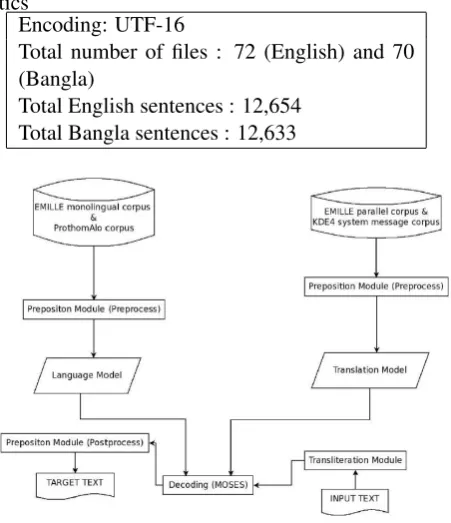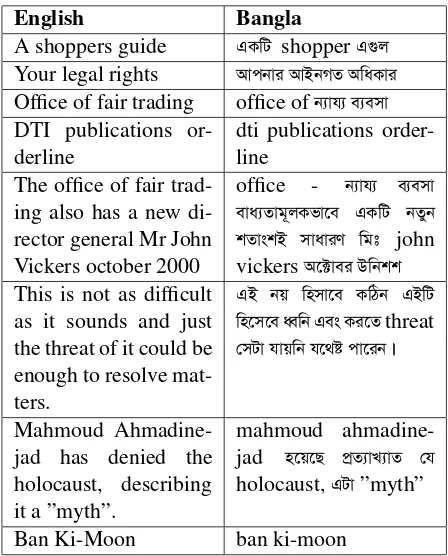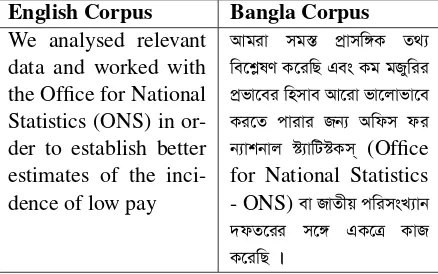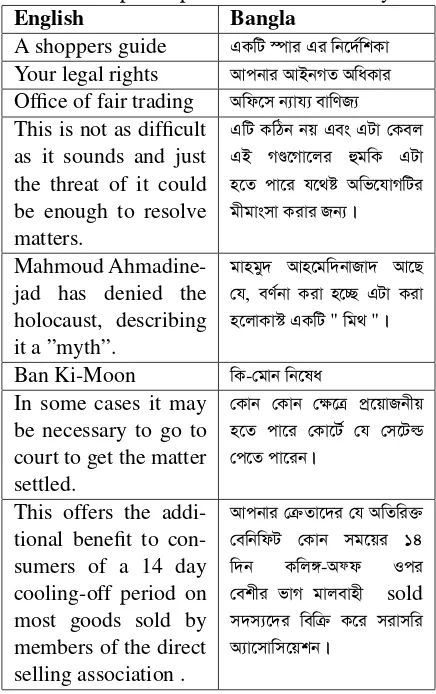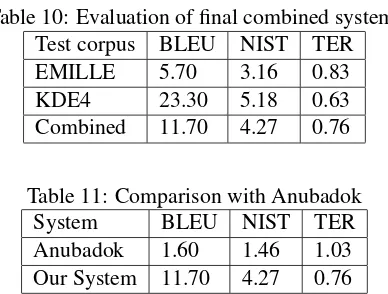English to Bangla Phrase-Based Machine Translation
Md. Zahurul Islam Dipartimento di Informatica
Universit`a di Pisa [email protected]
J¨org Tiedemann Department of Linguistics
and Philology Uppsala University [email protected]
Andreas Eisele Language Technology Lab DFKI GmbH, Saarbr¨ucken
Abstract
Machine Translation (MT) is the task of automatically translating a text from one language to another. In this work we de-scribe a phrase-based Statistical Machine Translation (SMT) system that translates English sentences to Bangla. A translit-eration module is added to handle out-of-vocabulary (OOV) words. This is es-pecially useful for low-density languages like Bangla for which only a limited amount of training data is available. Fur-thermore, a special component for han-dling preposition is implemented to treat systematic grammatical differences be-tween English and Bangla. We have shown the improvement of our system through effective impacts on the BLEU, NIST and TER scores. The overall BLEU score of our system is 11.7 and for short sentences it is 23.3.
1 Introduction
SMT requires enormous amount of parallel text in the source and target language to achieve high quality translation. However, many languages are considered to be low-density languages, either be-cause the population speaking the language is not very large, or because insufficient digitized text material is available in a language even though it is spoken by millions of people. Bangla/Bengali is one such language. Bangla, an Indo-Aryan lan-guage, is a language of Southeast Asia, which comprises present day Bangladesh and the Indian state of West Bengal. With nearly 230 million speakers, Bangla is one of the most spoken lan-guages in the world, but only a very small number of tools and resources are available for Bangla.
Our aim in this work is to present a phrase-based SMT system for translating English sen-tences to Bangla. The current state-of-the-art
phrase-based SMT systems available for this task is based on a log-linear translation model, which is used as our baseline system. Though we have built our system with a small amount of training data compared to MT systems of other language pairs, we have got better results than existing MT systems for this language pair when tested on the same domain. A transliteration module has been added as a component with the translation system to handle OOV words. For the transliteration mod-ule we applied the same phrase-based SMT model, but using characters instead of words. Another difference to standard SMT models is the prepo-sition handling module we added to our system to handle prepositional diversity between English and Bangla. Instead of prepositions, as in English, Bangla uses postpositions, or attaches inflections to the head noun of the prepositional phrase (i.e., the object of the preposition) (Naskar and Bandy-opadhyay, 2006b).
The rest of the paper is organized as follows. Section 2 summarizes some related past work. Section 3 shows the importance of preposition handing during translation. Section 4 describes the experiments and results. Finally, we summarize our observation, and outline future work in Sec-tion 5, followed by conclusion in SecSec-tion 6.
2 Related Work
vert CNF trees to normal parse trees using some conversion rules. Unlike a normal parse tree, each parent node in the CNF tree must have two chil-dren. In the next step, they use transfer rules and a bilingual dictionary to convert English parse trees to Bangla parse trees. Finally, they generate output translation with morphological generation.
Saha and Bandyopadhyay (2005) propose an English to Bangla Example Based Machine Trans-lation (EBMT) system for translating news lines. Here translation of source to target head-lines is done in three steps. In the first step, search in made directly in the example base; if it is not found there then it searches in the generalized tagged example base. If a match is found in the second step, then it extracts the English equivalent of the Bangla words from the bilingual dictionary and applies synthesis rules to generate the surface words. If the second step fails, then the tagged in-put headline is analyzed to identify the constituent phrases. The target translation is then generated from the bilingual example phrase dictionary, us-ing heuristics to reorder the Bangla phrases.
Naskar and Bandyopadhyay (2006a) present an EBMT system. This work identifies the phrases in the input through a shallow analysis, retrieves the target phrases from a set of examples and finally combines the target language phrases by employ-ing some heuristics based on the phrase reorderemploy-ing rules in Bangla.
Naskar and Bandyopadhyay (2006b) show a technique of handling prepositions in an English to Bangla machine translation system. In Bangla there is no concept of preposition. In many cases English prepositions are translated to Bangla by attaching inflections to the head nouns of the prepositional phrase. The English form of prepo-sition (prepoprepo-sition) (reference object) is translated to (reference object) [(inflection)] [(prepositional word)]. The reference object plays a major role in determining the correct preposition sense. For example:at homeshould be translated to the stem word ড়(bari : home) and the inflection- (-te).
Roy (2009) proposes a semi-supervised ap-proach for Bangla to English phrase based MT. A baseline system was built using a limited amount of parallel training data. The system randomly se-lects sentences from a Bangla monolingual corpus, and translates them using the baseline system. Fi-nally, source and translated sentences were added to the existing bilingual corpora. Acquiring
paral-lel sentences is an iterative process until a certain translation quality is achieved.
Anwar et al. (2009) propose a context-sensitive parser that is used in machine translation. Each Bangla sentence is converted to structural repre-sentation (parse tree), translation of each Bangla word is chosen from a bilingual dictionary and fi-nally English sentences are constructed with the help of a bigram language model.
There is an open source machine translation system called Anubadok (http://anubadok.sourceforge.net) available for translating English to Bangla. The translation process consists of three steps. First it converts different kind of documents into XML format. Then it tokenizes, tags and lemmatizes English sentences. In the next step, it performs the translation. At the beginning of the third step, it determines the sentence type, subject, object, verb and tense, and then translates English words to Bangla using a bilingual dictionary. Finally, it joins subject, object and verbs in the SOV order.
Transliteration systems are being used nowa-days in MT systems. UzZaman et. al (2006) present a phonetics based transliteration system for English to Bangla which produces intermedi-ate code strings that facilitintermedi-ate matching pronun-ciations of input and desired output. They have used table-driven direct mapping techniques be-tween the English alphabet and the Bangla alpha-bet, and a phonetic lexicon–enabled mapping.
Matthews (2007) presents a machine translitera-tion system of proper nouns using MOSES (Koehn et al., 2007). The system transliterates proper nouns in both directions in both English–Chinese and Arabic–English. He has achieved 43.0% ac-curacy of forward transliteration from Arabic to English and 37.8% from English to Chinese.
3 Importance of Preposition Handling
in the source and target language.
Instead of prepositions Bangla typically uses postpositions or inflectional attachment to the head noun (reference object). The noun is usu-ally in the genitive/accusative case unless the two words are placed under the rules of (Sandhi)1 or (Samas),2in which case the noun is not in-flected. Therefore, English prepositions are trans-lated to Bangla by attaching appropriate inflec-tions to the head noun (reference object). For ex-ample: inflection- (-te) attaches to the noun ড় (home) and it becomes ড়ে (at home), inflection -য়(-y) attaches to the noun (the evening) and it becomes য় (in the evening). The English form of preposition (preposition) (reference ob-ject) is translated to Bangla (reference obob-ject) [(in-flection)] [(postpositional-word)]. Our intuition is that handling prepositions during translation will improve the MT performance.
4 Experiment
4.1 Data and Tools
We have used a parallel corpora of South Asian languages called Enabling Minority Language Engineering (EMILLE) corpus developed by Lan-caster University, UK, and the Central Institute of Indian Languages (CIIL), Mysore, India. Infor-mation about EMILLE corpora is available here: http://www.elda.org/catalogue/en/text/W0037.html. This corpus is distributed by the European Lan-guage Resources Association. It contains 200,000 words of text in English and its accompanying translations in Hindi, Bangla, Punjabi, Gujarati and Urdu. The Bangla translation contains 189,495 words. Table 1 shows the EMILLE corpus statistics for English and Bangla. Before training the system we converted the file encoding to UTF-8. All the sentences have been extracted to text from XML mark up and aligned using an automatic sentence aligner. Finally, we tokenize the English and Bangla part of the corpus and convert the English text to lower case.
We also used KDE4 system messages as a cor-pus; the English and the Bangla translation of
1Sandhi is the euphonic change when words are
con-joined. For example: (Dhaka) +ঈ (Godess) = ে
(Godess of Dhaka), (bride) +উৎ (festival) = ৎ
(fes-tival to welcome a bride). Sandhi takes place on the simple joining of words in a sentence, on the formation of compound words and on the adding of affixes to noun or verbs.
2Samas is the rules of compounding words. For example:
(you)এ ং(and) (I) = (we).
Table 1: EMILLE English - Bangla corpus statis-tics
Encoding: UTF-16
Total number of files : 72 (English) and 70 (Bangla)
Total English sentences : 12,654 Total Bangla sentences : 12,633
Figure 1: System architecture
BN BD (Bangla in Bangladesh) and the BN IN (Bangla in WestBengal/India) domains. The KDE4 corpus has been taken from the OPUS cor-pus (Tiedemann and Nygard, 2004) which is al-ready aligned. This KDE4 system message cor-pus contains 221,409 words and 33,365 sentence pairs with UTF-8 encoding. We used the mono-lingual corpus from the EMILLE project and the Prothom-Alo corpus developed by BRAC Univer-sity, Bangladesh. The EMILLE monolingual cor-pus contains 1,867,452 words and the Prothom-Alo corpus contains 19,496,884 words.
Table 2: Sample output of baseline system
English Bangla
A shoppers guide এ ট shopperএ ল Your legal rights
Office of fair trading office of DTI publications
or-derline
dti publications order-line
The office of fair trad-ing also has a new di-rector general Mr John Vickers october 2000
office
-ল ে এ ট
ং ঃ john
vickers ে উ This is not as difficult
as it sounds and just the threat of it could be enough to resolve mat-ters.
এ য় ে ঠ এ ট
ে ে এ ং ে threat ট য় ে ে ।
Mahmoud Ahmadine-jad has denied the holocaust, describing it a ”myth”.
mahmoud ahmadine-jad েয়েছ
holocaust,এট ”myth”
Ban Ki-Moon ban ki-moon
the closeness of candidate transliteration with the reference transliteration.
4.2 System Architecture
Section 3 describes the importance of preposition handling during translation. A module is added to the system to handle prepositions. The preposition handling module is divided into two parts: prepro-cessandpost-process. Thepreprocesssub-module interchanges the positions of postpositional words and reference object. Moreover, it separates suf-fixes (inflections) from the reference object and puts that before the reference object with suffix marker. The post-processsub-module moves the postpositional words after the reference objects and adds suffixes to the next word (reference ob-ject). The preposition handling module is applied only on the Bangla corpus.
A transliteration module is also added, as we be-lieve that this modules will improve the translation quality and accuracy of our MT system. It is basi-cally responsible for identifying OOV words, and transliterates them in order to avoid the presence of English words in the target Bangla translation. Figure 1 shows the combined system architecture.
Table 3: Evaluation of basline system Test corpus BLEU NIST TER
EMILLE 1.20 1.65 0.90
KDE4 14.00 4.19 1.02
Combined 5.10 2.70 0.89
4.3 Baseline System
We constructed a parallel training corpus of 10,850 sentence pairs using the GMA sentence aligner (Dan Melamed, 1996). The English cor-pus contains 199,973 words and the Bangla corcor-pus contains 189,495 words. Each side of the KDE4 corpus contains 35,366 sentence pairs. The KDE4 Bangla corpus contains 221,409 words while the English corpus contains 157,392 words. We sepa-rated 500 sentence pairs from the EMILLE corpus and 1,000 sentence pairs from the KDE4 corpus for development sets. We also separated the same number of sentences from both corpus as a test set. The 5-gram language model was built from the EMILLE monolingual corpus, Prothom-Alo cor-pus and the training data, which together contain more than 21 million words. Table 2 shows sample output of the baseline system, and Table 3 shows the evaluation result of this system.
4.4 Corpus Cleaning
Table 2 shows that the output contains some En-glish words. The reason for this is the inclu-sion of many English words in the Bangla side of training, development and test sets, in some cases even entirely in English. This occurs for both the EMILLE and the KDE4 corpus. Therefore, we decided to clean the corpus in order to get better translation.
First of all, we wanted to improve the auto-matic sentence alignment of the EMILLE cor-pus. For this we experimented with the Interac-tive Sentence Aligner (ISA) (Tiedemann, 2006) tool. ISA is an interactive tool with web interface for semi-automatic sentence alignment of parallel XML documents. It uses a standard length-based approach to align sentences and allows to manu-ally add or remove segment boundaries to correct existing alignments in order to improve the overall quality of the parallel corpus.
Table 4: Irregularities in Bangla corpus
English Corpus Bangla Corpus
We analysed relevant data and worked with the Office for National Statistics (ONS) in or-der to establish better estimates of the inci-dence of low pay
ে ে ছ এ ং জ
ে ে েল ে
ে জ
ল ট (Office for National Statistics - ONS) জ য় ং
ে ে এ ে জ
ে ছ ।
Table 5: Evaluation of new translation system Test corpus BLEU NIST TER
EMILLE 5.10 3.1 0.84
KDE4 22.50 5.18 0.65
Combined 11.10 4.24 0.78
662 sentences, whereas the Bangla translation of this file has a total of 425 sentences. In various cases translations on either side were missing or moved. Another noticeable observation was that for organization or group name in the English text, there were Bangla translation, Bangla translitera-tion and names in English in the Bangla corpus. Table 4 shows example of these inconsistencies, ল ট is the transliteration and জ য় ং is the translation of ”Office for National Statistics”. Finally, we cleaned the cor-pus manually which took more than 120 working hours. We found two among seventy files where we could not align the sentences at all which were deleted from the corpus.
The KDE4 corpus also contains many English words in Bangla side. To clean this corpus we simply extracted sentence pairs where there is no English character on the Bangla side. Finally, we have obtained in total 9,111 sentence pairs from the EMILLE corpus and 16,389 sentence pairs from the KDE4 corpus.
Table 6: Sample English OOV words and their transliteration with XML markup
<np translation=” ”>office</np> <np translation = ” ”>shoppers</np>
<np translation = ” - ”>ki-mon</np>
Table 7: Evaluation of transliteration module
Test Set ACC Top 5 Top 20 M. F-score EN Names 0.187 29.68 79.68 0.797
Table 8: Evaluation of combining transliteration module with translation system
Test corpus BLEU NIST TER
EMILLE 5.40 3.13 0.83
KDE4 23.20 5.16 0.63
Combined 11.40 4.25 0.77
4.5 New Translation System
From the manually cleaned and aligned corpora we extracted the same number of sentences for development and test set as the baseline system. The new language model has been cleaned as well – we deleted all the sentences which contain En-glish characters. This time a 8-gram language model has been used. We compared different N-gram language models for Bangla and observed the best BLEU score for8-grameven though the output subjectively looks better when we use a 5-gram model. With all these changes we obained significantly better output compared to the previ-ous baseline system. Table 5 shows the evalua-tion result of the new translaevalua-tion system. We have achieved more than 100% improvement over the baseline system.
4.6 Transliteration Module
or OOV words. However, there are risks of us-ing a transliteration module for OOV words or names. When we transliterate names, the out-put translation contains some English words (un-known words), and when we transliterate OOV words, there are some words which should not be transliterated. We experimented with both and got better BLEU score when we transliterated OOV words.
We collected 2,200 unique names from Wikipedia and Geonames (www.geonames.org). To build this system, we tried to go a step further than the translation system and treated the words (names) as sequences of letters, which have to be translated into a new sequence of letters. We used the same tools as the translation system. For the language model (8-gram) we used the Prothom-Alo corpus and Bangla names from training. We just put one space between each character in the corpora. We used the same tools as the translation system (e.g. MOSES, GIZA++, MERT) and followed the same steps (e.g. training, tuning and testing) as well. Table 7 shows evaluation results of the transliteration system.
We identified OOV words by usingenglish.vcb as a vocabulary list which is generated by GIZA++ during alignment. Any word not in the vocabulary list is considered as an OOV word. We translit-erated all the OOV words using the transliteration module and replaced them with XML markup. Ta-ble 6 shows some sample English OOV words and their transliteration with XML markup. MOSES has an advanced feature by which we can provide external knowledge to the decoder during decod-ing. The -xml-input flag was raised with exclu-sive value so that the XML-specified translation (transliterated name) is used for the input phrase and any phrase from the phrase tables that over-laps with that span is ignored. Table 8 shows the evaluation result of combining the transliteration module with the translation system.
4.7 Preposition Handling Module
We have already mentioned the importance of han-dling prepositions during English to Bangla ma-chine translation. English prepositions are trans-lated to Bangla by attaching inflections to the head noun of the prepositional phrase, or as a postpo-sition word after the head noun. To implement the prepositional module, we took the intersec-tion of word alignment using the intersection
op-Table 9: Sample output of final combined system
English Bangla
A shoppers guide এ ট এ ে Your legal rights
Office of fair trading ে জ This is not as difficult
as it sounds and just the threat of it could be enough to resolve matters. jad has denied the holocaust, describing
In some cases it may be necessary to go to court to get the matter settled.
ে েয় জ য়
ে ে েট েট
ে ে ।
This offers the addi-tional benefit to con-sumers of a 14 day cooling-off period on most goods sold by members of the direct selling association .
tion during the training of MOSES. Then we ex-tracted the intersection word list from our train-ing corpus. As there is no freely available Parts of Speech (POS) tagger for Bangla, we used the OpenNLP (http://opennlp.sourceforge.net) tool to POS tag English words and transfer the tags to the aligned Bangla words. For many English words there was more than one candidate tag. In this case we considered only the top 1 candidate. Finally, we extracted the words that are tagged as noun.
We preprocessed corpora in two steps. Firstly, we come up with 19 postpositional words. We identified those postpositional words in the cor-pora and moved them before the reference object (head noun). Secondly, we came up with a group of 9 suffixes which can be attached to the nouns. We just stripped those suffixes from the nouns and put them in front of the noun with a suffix mark (#X#, where X is a suffix). We did these for train-ing, development and for the monolingual corpus for the language model.
word. Our assumption is that the word after any suffix will be a noun (reference object). We have checked the output after post processing. In very few cases, suffixes were attached to words that are not noun. We also identified each postpositional word, and move it after the next word. Table 9 shows the sample output of combining the prepo-sition handling module with the previous com-bined system. Table 10 shows the evaluation re-sult.
4.8 Comparison with Anubadok
We have compared our system with the open source MT system for English to Bangla called Anubadok. We have used the same test set as we used to evaluate our system. Our system clearly outperforms Anubadok. Table 11 shows the com-parison result. The BLEU score of the Anubadok system is 1.60 while our system’s BLEU score is 11.70.
5 Observation and Future Work
SMT systems require a significant amount of par-allel corpora to achieve satisfactory translations. However, there are not enough parallel corpora available for English and Bangla to achieve high quality translation using only a statistical MT system. Our system works reasonably well for short sentences. After transliterating all the OOV words, there are only a few remaining English words in the translated text. Table 9 shows that soldis an English word in the translated text. As a consequence, we have found 53 phrase-table en-tries where sold is the part of the phrase. But there is no phrase-table entry wheresold is a sin-gle phrase and also no entry wheresoldis follow-ing or precedfollow-ing any of the adjacent words in the test sentences. We have experimented with grow-diag-final, grow, and intersection alignment op-tions available in MOSES. In all the cases some English words were left in the translated text af-ter transliaf-terating all OOV words. Another notice-able observation in Tnotice-able 9 is that the word ”Ban” is wrongly translated. Here ”Ban” is the part of the name ”Ban Ki-Moon”, but in English ”Ban” is also a verb and the Bangla translation is ে which we can see in the output. This type of am-biguity will remain in our system.
Although satisfactory results (for a low–density language) were obtained with the current system and the additional modules, there is still a lot of
Table 10: Evaluation of final combined system Test corpus BLEU NIST TER
EMILLE 5.70 3.16 0.83
KDE4 23.30 5.18 0.63
Combined 11.70 4.27 0.76
Table 11: Comparison with Anubadok
System BLEU NIST TER
Anubadok 1.60 1.46 1.03 Our System 11.70 4.27 0.76
room for improvement in several parts of the sys-tem. Obviously the largest improvements can be expected when adding more parallel data for train-ing the system.
A test set with more than one reference would be useful to evaluate our system. Our plan is to de-velop a test set for English⇔Bangla MT system with more than one reference translation.
Another idea for future work is to extend the preposition handling component. Adding more postpositional words and inflectional suf-fixes would improve the system’s accuracy.
Furthermore, both English and Bangla have many compound words. Another module that could handle English compound words would be useful for an English⇔ Bangla MT system. Fi-nally, the integration of linguistic features is an-other direction for future work. We like to work on the enhancement of the phase-based SMT model with some features representing syntactic informa-tion and morphological informainforma-tion. We also need to add more names in the training data in order to improve the transliteration quality.
6 Conclusion
an improved impression of translation quality. The preposition handling module is also effective to improve translation accuracy. Even though there is not much improvement after combining the base-line system with the preposition handling mod-ule, the results suggest that prepositions should be handled separately in the English⇔ Bangla ma-chine translation. Overall we obtained reasonable scores for short sentences (23.30 BLEU and 0.63 TER). However, on average the scores are still much lower with BLEU: 11.70, NIST: 4.27 and TER: 0.76.
Acknowledgments
We would like to thank the Erasmus Mundus Eu-ropean Masters Program in Language and Com-munication Technologies (EM-LCT) for support. This work was carried out while the first au-thor was an EM-LCT student at the University of Groningen. One of the authors was supported by the EuroMatrixPlus project funded by the Euro-pean Commission under FP7.
References
Md. Musfique Anwar, Mohammad Zabed Anwar and
Md. Al-Amin Bhuiyan. 2009. Syntax Analysis and
Machine Translation of Bangla Sentences, Interna-tional Journal of Computer Science and Network Se-curity, 09(08),317–326.
Sajib Dasgupta, Abu Wasif and Sharmin Azam. 2004.
An Optimal Way Towards Machine Translation from English to Bengali, Proceedings of the 7th Inter-national Conference on Computer and Information Technology (ICCIT).
George Doddington. 2002. Automatic Evaluation
of Machine Translation Quality Using N-gram Co-Occurrence Statistics, Proceedings of the second international conference on Human Language Tech-nology Research.
Xue Jiang and Le Sun and Dakun Zhang. 2009. A
Sylleable-based Name Transliteration System, Pro-ceedings of Name Entities Workshop(NEW) 2009, ACL–IJCNLP.
Philipp Koehn, Hieu Hoang, Alexandra Birch, Chris Callison-Burch, Marcello Federico, Nicola Bertoldi, Brooke Cowan, Wade Shen, Christine Moran, Richard Zens, Chris Dyer, Ondrej Bojar, Alexandra
Constantin and Evan Herbst. 2007. Moses: Open
Source Toolkit for Statistical Machine Translation, Annual Meeting of the Association for Computa-tional Linguistics (ACL).
Dan Melamed. 1996. A Geometric Approach to
Map-ping Bitext Correspondence, Proceedings of the
First Conference on Empirical Methods in Natural Language Processing (EMNLP).
David Matthews. 2007. Machine Translation of
Proper Names, Masters Thesis, School of Informat-ics, University of Edinburgh.
Sudip Kumar Naskar and Sivaji Bandyopadhyay.
2006a. A Phrasal EBMT System for Translating
En-glish to Bengali, Proceedings of the Workshop on Language, Artificial Intelligence, and Computer Sci-ence for Natural Language Processing Applications (LAICS–NLP).
Sudip Kumar Naskar and Sivaji Bandyopadhyay.
2006b. Handling of prepositions in English to
Ben-gali Machine Translation, Proceedings of the EACL 2006 Workshop.
Franz Josef Och 2003.Minimum error rate training in
statistical machine translation, Proceedings of the 4th Annual Meeting of the Association for Compu-tational Linguistics (ACL).
Franz Josef Och and Hermann Ney 2003.A Systematic
Comparison of Various Statistical Alignment Mod-els, Journal of the Computational Linguistics, 29(1), 19-51.
Kishore Papineni, Salim Roukos, Todd Ward and
Wei-Jing Zhu. 2001. BLEU: a Method for Automatic
Evaluation of Machine Translation, Proceedings of the 40th Annual Meeting on Association for Com-putational Linguistics.
Maxim Roy 2009. A Semi-supervised Approach to
Bengali-English Phrase-Based Statistical Machine Translation, Proceedings of the 22nd Canadian Conference on Artificial Intelligence.
Diganta Saha and Sivaji Bandyopadhyay. 2005. A
semantics-based English-Bengali EBMT system for translating news headlines, Proceeding of MT Sum-mit X second workshop on example-based machine translation.
Matthew Snover, Bonnie Dorr, Richard Schwartz,
Lin-nea Micciulla and John Makhou. 2006. A Study
of Translation Edit Rate with Targeted Human An-notation, Proceedings of Association for Machine Translation in the Americas.
Andreas Stolcke 2001.SRILM–an extensible language
modeling toolkit, Proceedings of the ICSLP.
J¨org Tiedemann and Lars Nygard. 2004. The OPUS
corpus - parallel and free, Proceedings of LREC 2004.
J¨org Tiedemann 2006. ISA and ICA – Two Web
Inter-faces for Interactive Alignment of Bitexts, Proceed-ings of LREC 2006.
Naushad UzZaman, Arnab Zaheen and Mumit Khan.
2006.A Comprehensive Roman (English) to Bangla
